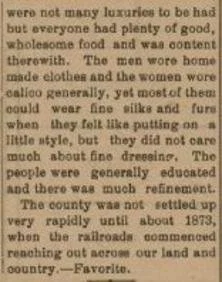A Bit of Fannin County History
This article, apparently originally published in the Favorite, was republished in the Honey Grove Signal on December 24, 1909.
The county was organized in 1838. Bonham became the county seat in 1841. The county in its first settlement was not considered as a suitable place for farming, as it was subject to protracted drouths, and only along the river bottoms was it considered suitable for agricultural purposes, but it was a fine grazing country; cattle and horses could live all winter without having to be fed. Grass was abundant everywhere. Hogs that ran loose in the belts of timber kept fat on the mast, acorns and pecans being abundant. The most of the citizens were cattlemen who only cultivated wheat and barley—the one for bread, the other for use as feed for their saddle horses. The most of the population came from Tennessee and Kentucky, and settled in North Texas. The cattle were driven to St Louis and Kansas City for market and was the principal thing from the sale of which money was derived. The little surplus wheat that was raised was ground into flour on ox mills and was hauled to the pine mills of East Texas and exchanged for lumber. Hides and pecans were the only exports. The mode of transportation was by ox teams, seven or eight yoke being hitched to a large wagon upon which three to four thousand pounds could be hauled. The merchandise that came to this market was hauled on these wagons. The most of the goods were shipped up the river by steamboat to Shreveport and Jefferson (sometimes the boats ran as high up as Rowland) and from these places was hauled to this country.
Up to fifty years ago Bonham and Honey Grove were the only towns (and they were small villages) in the county. Honey Grove had three stores—Sinclair Stapp, B. S. Walcott and Cole & Stobaugh—all of whom did a good business. Bonham had four stores—C. C. Alexander, J. W. and J. R, Russell & Company, Nunnelee & Hofford and W. D. and J. B. Oliphint. Alexander did a large wholesale business, furnishing the forts and outposts of this frontier for 150 miles to the north and west. There was not a day during the year but he was receiving and unloading goods and also selling and sending off goods. His purchases amounted to probably more then half a million dollars per year. J. W. and J. R. Russell also did a large wholesale trade. The other merchants confined themselves to a retail business, which brought customers for thirty miles around.
The people were noted for their kindness and hospitality. There were not many luxuries to be had but everyone had plenty of good, wholesome food and was content therewith. The men wore home made clothes and the women wore calico generally, yet most of them could wear fine silks and furs when they felt like putting on a little style, but they did not care much about fine dressing. The people were generally educated and there was much refinement.
The county was not settled up very rapidly until about 1873, when the railroads commenced reaching out across our land and country. - Favorite.ty settler]


